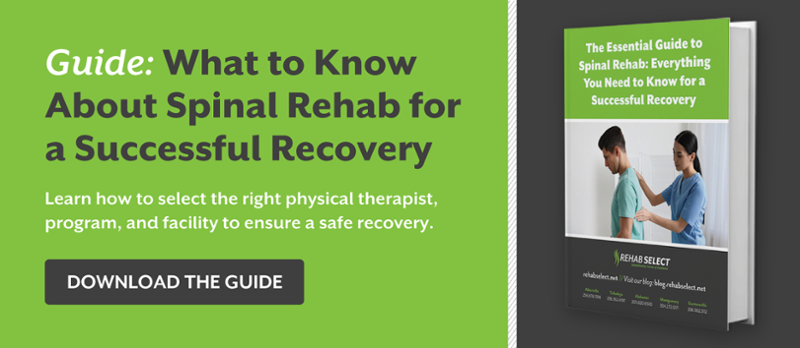
Spinal surgery recovery and the time it takes to return to normal activities vary for every person. Factors that may affect the prognosis for a full recovery include the type of surgery, symptoms, and degree of disability before the surgery, age, weight, nutrition, diet, and chronic medical conditions. Lifestyle behaviors, such as smoking, alcohol consumption, and being sedentary, can affect your body’s ability to heal and prolong recovery time.
To understand why the approach to recovery is critical, it’s important to review how the weeks immediately following surgery affects your rehabilitation. Here we examine some of the most important things to know about the crucial time period immediately following surgery.
Spinal Surgery Results: Recovery Considerations
The time it takes to recover from spinal surgery depends on the type of procedure performed. Spinal fusion surgeries are more complex than discectomies and can take up to two years for your spine to heal. However, you may be able to recover fully from a discectomy in about 12 weeks.
Symptoms
The most common symptoms people experience after spinal surgery are pain, stiffness, muscle cramps, fatigue, sleep problems, and feeling discouraged or depressed.
Complications
Most people will not have complications after surgery; however, if you have any of the symptoms below, contact your physician.
- Persistent or worsening pain.
- Signs of infection, including fever, chills, redness, swelling, pus or drainage at the site of the incision.
- Signs of a blood clot, including swelling, redness, increased pain in your legs, chest pain, or sudden difficulty breathing.
- Numbness, tingling, muscle weakness, or loss of bladder or bowel control may indicate nerve damage.
The Role of Opioid Pain Medications and Spinal Surgery Pain
Spinal surgery results typically include pain and stiffness, but as healing begins, it should start to improve. Narcotic pain medications may be needed to control pain levels immediately after surgery; however, they should be gradually decreased as tolerated to prevent dependence and addiction.
Some patients will continue to have severe pain after spinal fusion and develop a syndrome called Failed Back Surgery Syndrome (FBSS). To control their pain, these patients frequently receive long-term narcotic pain medications, and addiction has become a significant issue. Opioids are widely used for pain control because of their effectiveness, but dependence on these drugs can occur in a short period. The longer an individual takes an opioid, the higher their tolerance levels become, which leads to them increasing the dose to feel the effects of the drug. There are other treatments for FBSS, but no gold standard therapy has been identified.
Cervical and Lumbar Spinal Fusion: Recovery Takes Time
Many people feel better immediately after surgery, but strengthening muscles and tissues requires a comprehensive rehabilitation program consisting of exercises, physical therapy, and occupational therapy.
Cervical and lumbar fusion surgery recovery occurs in stages. Most medical experts predict that the average length of a hospital stay will be approximately two to four days.
Stages of Recovery
Day 1: The day after the surgery you will probably have some type of neck or back brace that needs to stay on until your surgeon advises you to remove it. With the help of a physical therapist, you will probably be encouraged to sit and stand on the edge of the bed within 24 hours after the surgery. The dressing on the surgical site will be changed and the wound inspected for inflammation and/or infection. Intravenous pain medications will be available after the surgery to keep you comfortable. Pain control is important so that you can participate in the rehabilitation program.
Weeks 1 to 4: You will mainly focus on resting, healing your spine, and allowing the discs to fuse. Activities will be limited during this stage.
Weeks 5 to 9: Physical therapy exercises usually begin at this time and are extremely important in helping your body heal. You will focus on strengthening the muscles in your neck and back to better support your spine. Getting enough rest is also important at this stage. Activities may include bending, twisting, while lifting heavy objects will be restricted.
Weeks 10 to 24: The focus of recovery changes around 10 weeks, and you will increase your activity with the help of a physical therapist in a post-surgical rehabilitation program. At this time, you will begin stretching and cardiovascular exercises. Activities including bending and lifting heavy objects are still restricted.
6 Months to 1 Year: If all goes well, you can expect to be cleared to return to all activities at this time as long as the orthopedist confirms that the fusion was successful.
1 to 2 Years: Most people have fully recovered at this stage. Fusion of the spine will continue until about 18 months, and it may take up to two years for nerve damage to heal.
Planning for Spine and Disc Rehabilitation After Surgery
Preparing and planning for spinal surgery recovery beforehand is an essential part of the rehabilitation process. Most physicians will recommend that you stop smoking and drinking alcohol before the surgery to prevent issues with healing and prolonged recovery.
Spinal surgery pain control is usually a major concern of patients undergoing spinal fusion. It is important to have a discussion with the surgeon about options for pain relief and what to realistically expect after surgery.
A pain control plan should be in place before the surgery is performed. Guidelines that can help reduce post-operative pain and improve outcomes include:
- Know which physician will be responsible for postoperative pain management.
- Discuss realistic expectations of pain levels and management at different stages of spinal surgery recovery.
- Discuss options for pain medications.
- Identify non-medication interventions that can reduce pain, such as hot/cold packs, mindfulness meditation, relaxation exercises, and cognitive behavior therapy.
- Find out how to get in touch with your physician if pain increases and is not controlled by medication and non-medication interventions.
Our Spinal Surgery Rehabilitation Program
Rehab Select offers both post-surgical and orthopedic inpatient rehabilitation programs to help you with your spinal surgery recovery. The care provided is similar for both programs, but post-surgical spine and disc rehabilitation offers professional wound care and pain management. The inpatient orthopedic rehabilitation program is designed to help patients recover from spinal cord and spinal column injuries as well as those that affect the muscles, bones, and joints. A multidisciplinary team will be involved in your care and will develop a customized treatment plan based on your physical, emotional, and social needs.
Schedule a meeting or tour at one of our five locations and discover Rehab Select, the premier rehabilitation facility for spinal surgery in Alabama.





